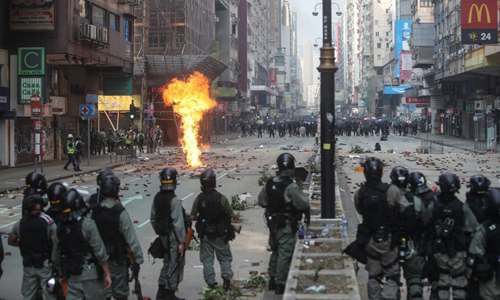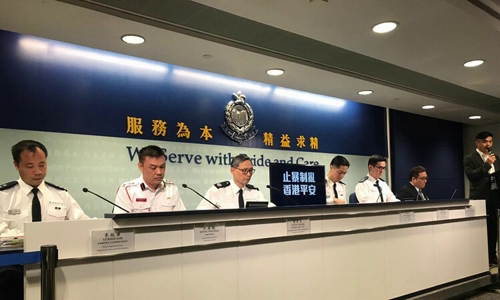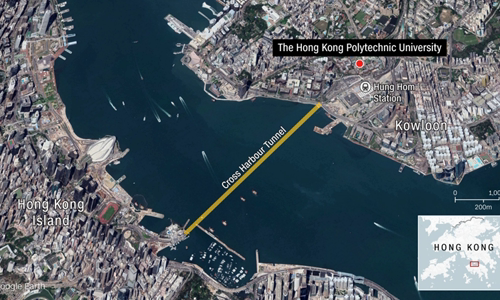The commander of the Kowloon Police urged protesters in Hong Kong Polytechnic University to surrender and demand that they do not use violence.
Speaking at a police press conference today, West Kowloon Regional Police Commander Cheuk Hau-yip said that Hong Kong Polytechnic University (PolyU) in the Hung Hom area of Kowloon urban area had been attacked. East occupied over a week.

Hong Kong police and protesters confronted the Yau Ma Tei and Jordan areas today Photo: SCMP
"They are free to enter and resupply. We have given them enough time before taking action," he said, adding that the police arrested 51 people wearing press shirts or first-aid workers after they were taken. receive intelligence that protesters will disguise themselves as reporters or first aid workers.
According to Cheuk, police found at least 12 of those wearing first-aid workers had no first-aid knowledge and some of them were journalists but did not have a journalist's card. He called on protesters on campus to "go out and surrender" but they would be arrested for rioting and demanded they do not use or support violence.
"Anyone who enters the Polytechnic campus is involved in a riot," Cheuk said. Police also said they were using tear gas only because protesters "suddenly tried to leave campus" with petrol bombs.
Chief Kwok Ka-chuen said police were seeking to end the deadlock situation in PolyU peacefully. "If extremists give up their weapons, follow police instructions and take legal responsibility, police will not use force," Kwok said.

Hong Kong police official at the press conference today Photo: CNN
Police said they had fired live bullets twice in the past two days, and condemned the violence against police, in the case of an officer hit by an arrow on November 17. "There is no doubt this is an act of murder. The arrow may have killed our officers or anyone around," the police spokesman said, condemning the police. This attack is "like terrorism" and protesters "plan to kill" the police.
Kwok Ka-chuen, an official with the police's public relations unit, said police had arrested a total of 4,491 people since the protests broke out in early June to protest the extradition bill, including 3,395 men. and 1,096 women, ages 11 to 83. They were mainly arrested for crimes related to riot, possession of assault weapons, arson, and police attacks.
Over the weekend, 154 people were arrested as violence escalated over alleged participation in illegal gatherings, riots and arson.
The press conference took place between police and protesters confronted at PolyU the past two days. The police surrounded the outside and sealed off the roads around the school, while many protesters tried to escape but were repelled by police tear gas. Police deployed an armored vehicle and a tornado on Chatham South Road, south of the PolyU campus and fired tear gas at protesters on the road.

Hong Kong Polytechnic University (red dot) on the southern end of the Kowloon Peninsula, was turned into a base by protesters to block nearby roads and the Trans-Port Tunnel, a transport artery connecting Kowloon to Hong Island. Kong Photo: Google Earth
Ken Woo Kwok-wang, president of the PolyU student union, said that about 600-700 people are on campus, of which about half are PolyU students. "We are trapped and there is not enough food. The number of injured people is increasing," he said.
Dr Rodney Chu Wai-chi, PolyU board member, said police were trying to block the campus to force protesters to surrender. The school can only arrange Red Cross staff to support those inside this afternoon. He also said on-campus protesters lost confidence when they saw the first group of protesters arrested for leaving the school through a police-directed escape on the evening of November 17.
Hong Kong first experienced protests and violent clashes that lasted for a week since June, resulting in one death and several serious injuries. Previously, protests only took place on the weekends. The protests initially opposed the extradition bill, allowing criminals to be sent to jurisdictions where the Special Zone has not signed an extradition treaty, including mainland China. After the bill was withdrawn by the authorities, protesters took to the streets, making other demands, including investigating the use of force by police and Hong Kong leader Carrie Lam.
Demonstrations increased when Hong Kong planned to hold district elections on November 24, selecting 400 members for 18 county councils. This is arguably an important "thermometer" for public opinion before the current protests. District council members actually do not have much power, but can greatly influence how the Legislative Council and the special zone chief are chosen in the future.
Hong Kong Polytechnic University (red dot) on the southern end of the Kowloon Peninsula, was turned into a base by protesters to block nearby roads and the Trans-Port Tunnel, a transport artery connecting Kowloon to Hong Island. Kong. Graphics: Google Earth.



 NanaK-Smart
NanaK-Smart







